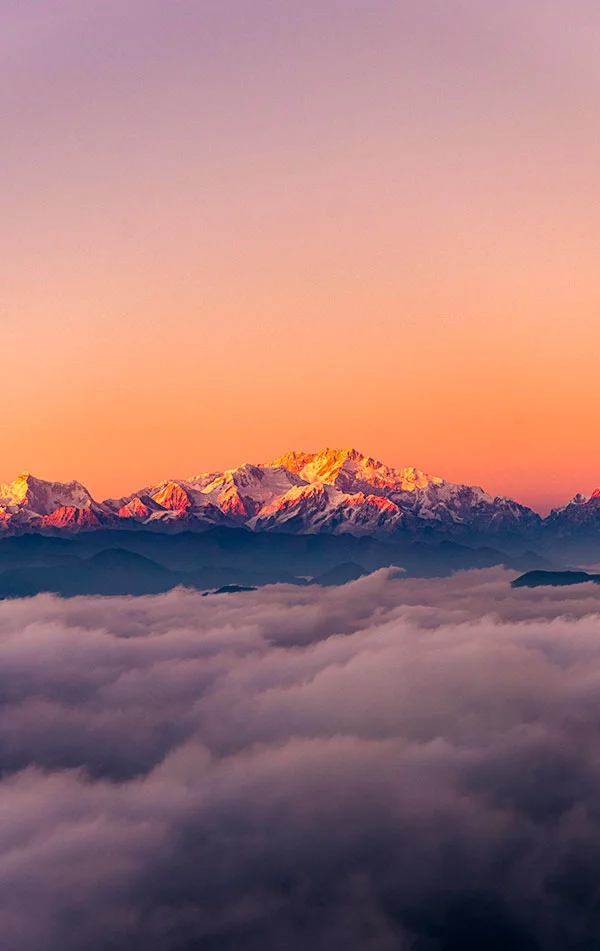
Region
West Bangal | India
Duration
7 Days
Max Altitude
12000 Ft.
Trekking Km
68 KM
Grade
Moderate to Difficult
Help & Support
+91 9368692892 info@trekthehimalayas.com10:00 hrs to 18:00 hrs | GMT +5:30
Monday - Saturday | Sunday Closed
12300 /Person
- May-2024
- +5% GST (goods and services tax)
- Services Sepi to Sepi
- Addons
-
Insurance is Mandatory.
-
Non-Indian rates are slightly higher. Trek coordinator will provide balance payment link post-booking.
- Get insurance through us or elsewhere. If not through us, email for a refund after booking.
-
Cancellation 4 or more days before the start of the trip results in a 100% cash refund.
-
Cancellation less than 4 days from the start of the trip results in no refund.
-
Transportation New Jalpaiguri Junction (NJP) to Sepi & retun is optional
-
Choose add-ons during booking. If missed, log in and add them later
-
Book transportation at least 10 days before the trek.
-
Cancellation 4 or more days before the start of the trip results in a 100% cash refund.
-
Cancellation less than 4 days from the start of the trip results in a 50% cash refund.
-
Cancellation after the trip date does not qualify for a refund.
-
Backpack offload is optional
-
Choose add-ons during booking. If missed, log in and add them later.
-
Book off-load at least 10 days before the trek.
-
For offline bookings at the base camp, a convenience fee of Rs. 2500 applies.
-
Cancellations made before the trip date will receive a full refund.
Insurance 245
Transport 2500
Offload 1800
For more information. Please complete this form.
Help & Support
+91 991 772 4737info@trekthehimalayas.com 10:00 hrs to 18:00 hrs | GMT +5:30
Monday - Saturday | Sunday Closed
Overview
Trek Name: Sandakphu Trek
Days: 7
Adventure Type: Trekking
Base Camp: Sepi
Season:Spring | Summer | Autumn | Winter |
Month:January | February | March | April | May | June | September | October | November | December |
Country: India
Altitude: 12000 Ft.
Grade: Moderate to Difficult
Rail Head: New Jalpaiguri (NJP)
Stay: Tea House
Food: Meals while on trek & at tea houses (Veg & Eggs)
Location: West Bangal
Distance: 68 Km.
Trail Type: Cross over trail | Start in one valley, traverse the pass, and ends in another valley.
AirPort: Bagdogra International Airport, which is 14 km away from New Jalpaiguri
Highlights:
- +5% GST (goods and services tax)
- Services Sepi to Sepi
Why is Sandakphu Phalut A Must-Do Trek?
The Sandakphu Trek in winter is a breathtaking challenge in the Indian state of West Bengal. Renowned for its panoramic views of the worlds highest mountains, including Mt. Kanchenjunga and Mt Everest, this trek is a winter wonderland for adventure enthusiasts and nature lovers. From the summit, one can witness the four tallest mountains in the world – Mt.Everest, Lhotse, Makalu and Kanchenjunga in the popular ‘Sleeping Buddha’ formation.
The trek takes place in the Singalila National Park, situated on the border between India and Nepal. It starts from various points, such as Maneybhanjyang or Dhotrey, and leads to Sandakphu, which is a prominent peak in the region. In winter, the trail is covered with snow and you can witness the beautiful snow-clad beauty of both West Bengal and Eastern Nepal. The crisp winter air and clear skies provide the ideal conditions for exploring the Himalayas.
Highlights
Spectacular Mountain Views
The most prominent highlight of the Sandakphu Trek is the panoramic view of the worlds highest peaks. You can witness Mount Everest, Lhotse, Makalu, and Kanchenjunga, along with numerous other mountains, creating a breathtaking visual feast.
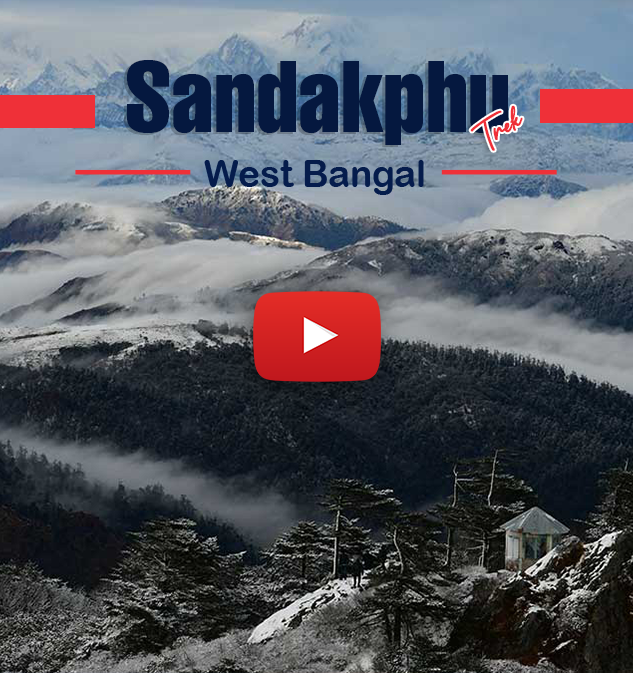
Who Can Participate
-
Age; 12 years +.
-
First timers can apply; previous trekking experience is more appreciated.
-
The climber must be fit and have sufficient stamina to cover 5 km of distance in 30 minutes without stress.
-
The climber should be able to carry a 10-15 kg backpack.
-
Pulse rate at rest must be in between (60 to 90 beats per minute)
-
Blood Pressure Reading must be in between (DIASTOLIC 70 – 90, SYSTOLIC 100 - 140 mm Hg)
-
Respiratory rate at rest must be in between (12 to 20 breaths per minute)
-
Should not have Liver and kidney issues
-
Should not have Diabetes Mellitus, Bronchial Asthma, Heart problems, Hypertension etc
-
No pacemaker implant
-
People with the Sinus issues, Epilepsy please contact to trek coordinator before booking the trek
-
If your BMI is not normal, Please contact our Trek coordinator before Trek booking.
Medical & Disclaimer Form (Mandatory Documents) Click here to download Medical & Disclaimer Form
- Government Employees can avail the benefit of Special Casual Leave (SCL) when you join us for a trekking expedition. As per the rules of the Pay Commission, Special Casual Leave can be availed for up to 30 days in a calendar year for trekking/mountaineering expeditions through a registered organization. Trek The Himalayas is a registered adventure tour operator by Indian Mountaineering Foundation (IMF) and Ministry Of Tourism (MOT)
- Trekkers have to apply for leave at least 20 days before trek departure date,
- This service is exclusive to Indian government employees and is applicable only for treks within India.
- Do mail at info@trekthehimalayas to apply and mention your booked trek date and trek name.
- Junior trekkers (below 15 years) should have a company of parents/guardians.
- Trekkers between 15 to 18 years can come solo with the disclaimer form signed by parent/guardian.
- Medical & Disclaimer Form (Mandatory Documents) Click here to download Medical & Disclaimer Form
Itinerary
Drive From NJP To Sepi
The journey to the beautiful Sandakphu trek begins today. Our team will pick you up from NJP Railway Station and you will be driven towards Sepi, which will be the base camp for your Sandakphu-Phalut trek. It is an uphill drive of about 130 km to the base camp and takes about 7 hrs. You will be passing through the native tea estates of Darjeeling and Sikkim as you drive towards Sepi. Momos and delicious Thukpa is a delicacy that you must surely try along the way. They are simply mouth-watering.
En route, your first stop will be Mirik, which is also a popular tourist destination in West Bengal. This picturesque and quaint hill station is located in the serene hills of the Darjeeling district. The climate and natural beauty of Mirik attract a lot of tourists here. We will reach Mirik at around 1:00 clock in the afternoon, where we will have our lunch. Try the local delicacies, they are simply great!
After your lunch, we will resume our journey again towards Sepi, which is your base for the trek and is definitely also a very pretty campsite. The greenery surrounding Sepi makes it look very beautiful and feel pretty close to nature here. Srikhola spring also cuts through the village of Sepi, which adds to the beauty of the landscape.
En route to Sepi, you will also cross some charming villages like Rimbik, Sukhipokhri, and Dhotrey as well. The more you travel uphill, the more tranquil it becomes with no noise of bustling city life all around you. Your accommodation for today will be arranged in a homestay. So, enjoy the hospitality and rest well as you begin tomorrow.
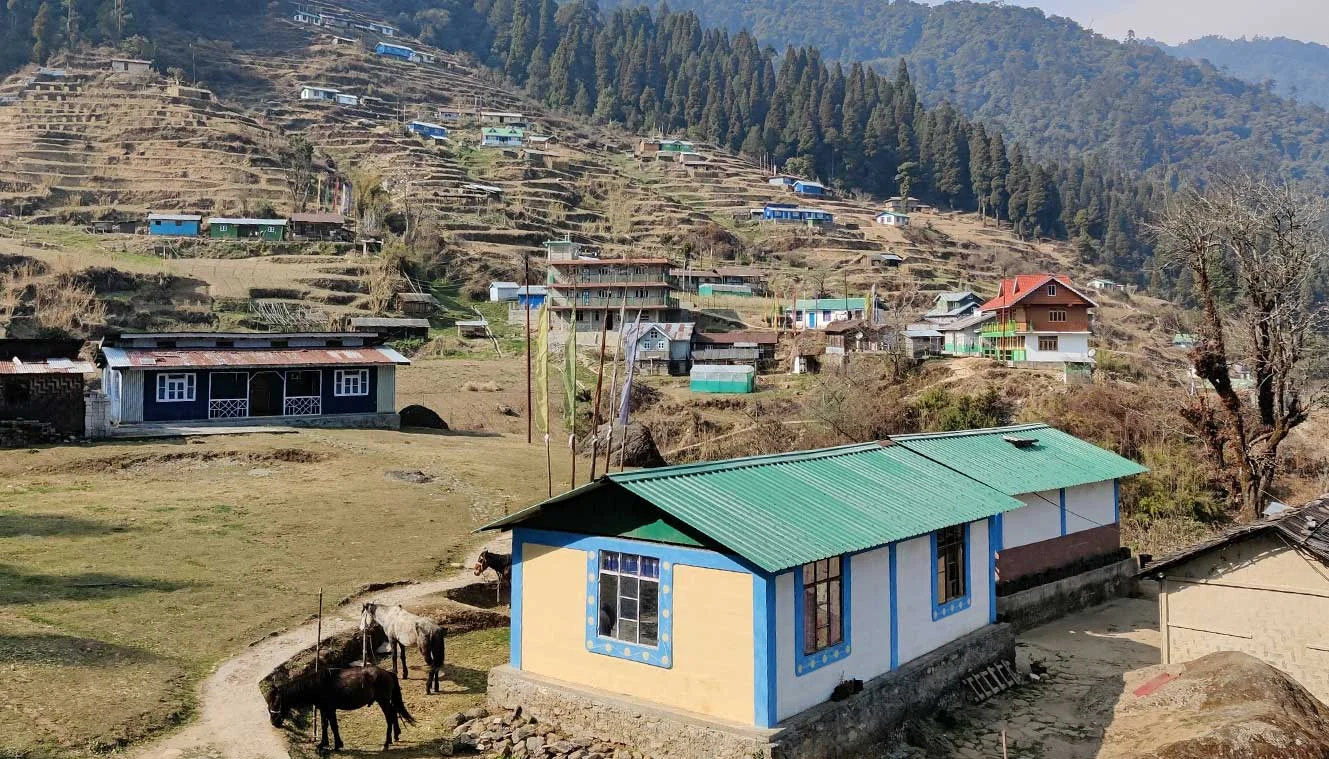
Trek From Sepi To Gorkhey via Ramam-Samanden
Wake up and lace up your trekking boots, today we are going to start our trek towards Sandakphu. Starting the day early, it's a considerably easy walk to Ramam with a gradual ascent and some steep sections. Maintain a steady pace and rest for a few moments if needed. Ramam is approximately 3.5 km away from the Sepi campsite. The trail here is a constructed route for most parts and you will notice several cut fields and tiny dwellings on the way. Take a short break at Ramam if you need to and then we will head on towards Samanden.
As you move out of Ramam, the trail becomes more secluded with the huts disappearing and the forest trail starting to open up. Walking through the quiet forest with the sound of nature all around you is a great experience in itself. The Singalila Range is quite popular for its abundance of greenery and you can now feel the same. For about 6 km you will traverse through the forests until you arrive at a bridge.
After the bridge, it's a steep climb for 15 minutes or so, following which you will arrive at a zone where there are stone benches, each dedicated to locals who have passed away. The locals made these benches with the kind intention that those who have passed away can serve the passersby even after their death by providing them with a place to rest.
From this point on, the trail begins to ease out a bit for a few minutes post which you arrive at a clearing dotted with wooden huts and farmlands. This is the beautiful Samanden village. Samanden has a very picturesque setting and the locals here are very friendly. Chat up with the locals and hear their interesting stories and you will also be greeted with incredible hospitality. The simplicity and the tranquility of the place may take you by surprise.
A couple of kilometres more and you will arrive at the Gorkhey campsite. Gorkhey is a small village situated in the northern part of West Sikkim and is pretty close to the state border. Gorkhey is an ideal location to halt for the night before we continue on our Sandakphu trek.
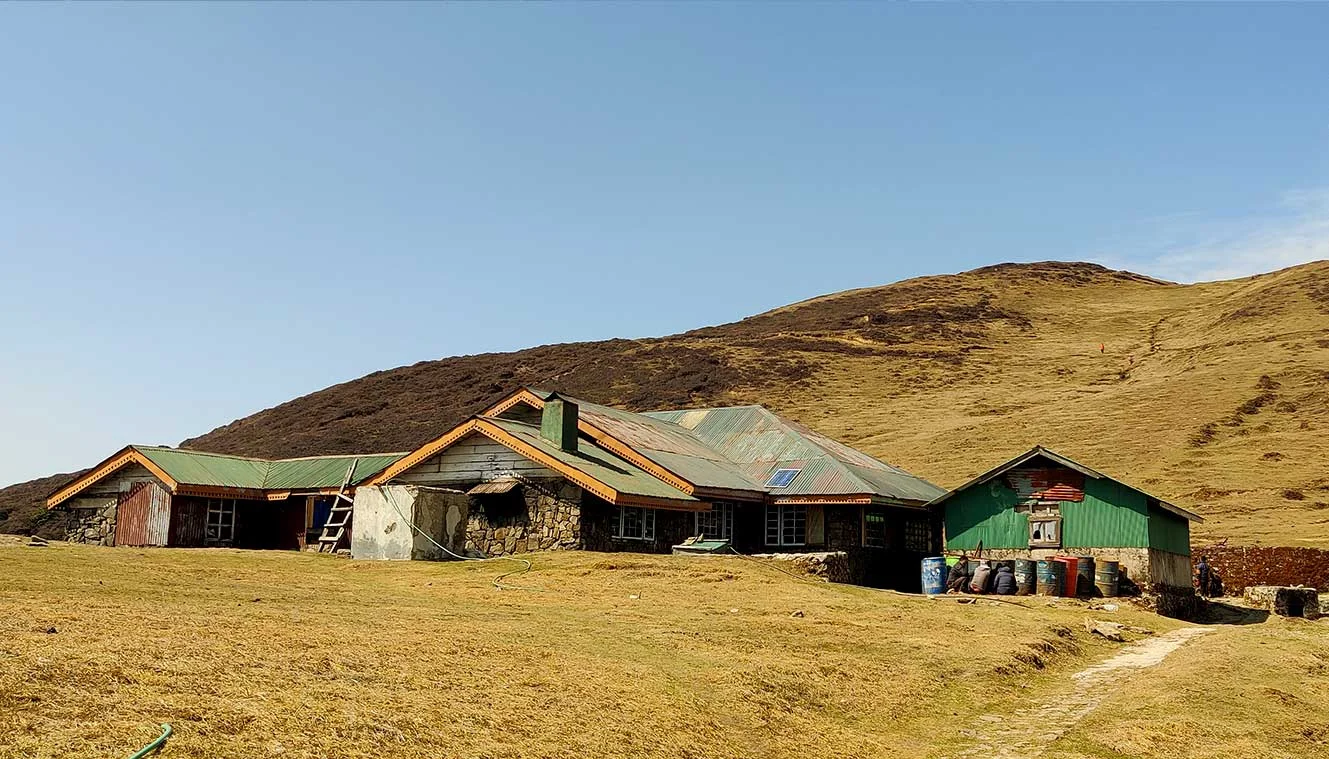
Trek From Gorkhey To Phalut
Start your trek early in the morning from Gorkhey towards Phalut. It is about 15 km from Gorkhey. The beautiful Gorkhey Khola flows through the village of Gorkhey after which it is named. It is a tributary of the Ramam River. Crossing this picturesque setting we will head on towards Phalut.
You will again cover long sections of forested trails today, be prepared as you have to continue ascending for a long distance and at some points, the ascent can be pretty steep. You may spot plenty of Oaks and Rhododendrons on the forested path. Maintain a steady pace along the trek.
It takes about 5 hrs to reach Phalut. Phalut is one of the highest peaks of the Singalila Range, it is the second-highest point after Sandakphu Ridge. To reach from Gorkehy to Phalut, you also need to get permits, which can be acquired from the Gorkhey check post.
En route to Phalut, you will get to see the Singalila Range from up close and you will get to see a stunning view of the Kanchenjunga Massif as well. The closer you get to Phalut the more beautiful the landscape gets. At 11,450 m Phalut offers stunning mountain views. Your stay is arranged in camps and after a delicious dinner, you will rest under the canopy of a million stars. Keep in mind that Phalut does not have electricity and everything runs on the solar panel, so keep extra batteries and power banks with you for your gadgets.
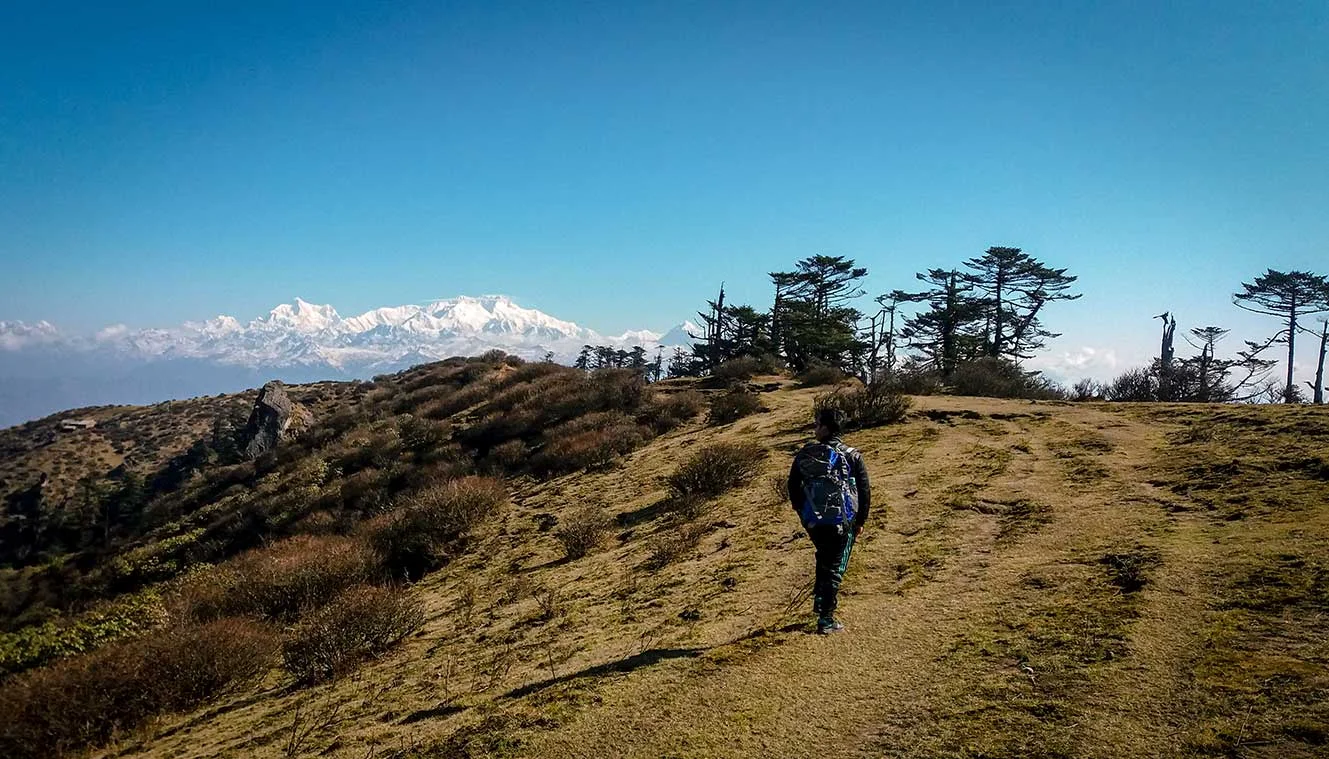
Trek From Phalut To Thakom
The next day we will start our journey towards Thakum. If you didn’t know Thakum campsite is located in Nepal, so we will be skirting the Indo-Nepal border into Nepal. Thakum is a beautiful valley that falls on the way to Sandakphu between Sabargram and Sandakphu and has a very soothing and relaxing vibe with beautiful meadows and a picturesque setting.
En route to Thakum, you may spot some Yaks grazing in the meadows and you have crossed the Indo-Nepal border into Nepal. Although it is a remote and unknown location, the views here are stunning and extremely admirable. The route to Thakum is also lined with a thicket of Rhododendron trees.
Sleeping Buddha formation stays in the backdrop as you cross some abandoned huts and cattle grounds. From Thakum, several routes branch into Nepal. This is your campsite for the night. We will pitch our tents here and rest for the night.
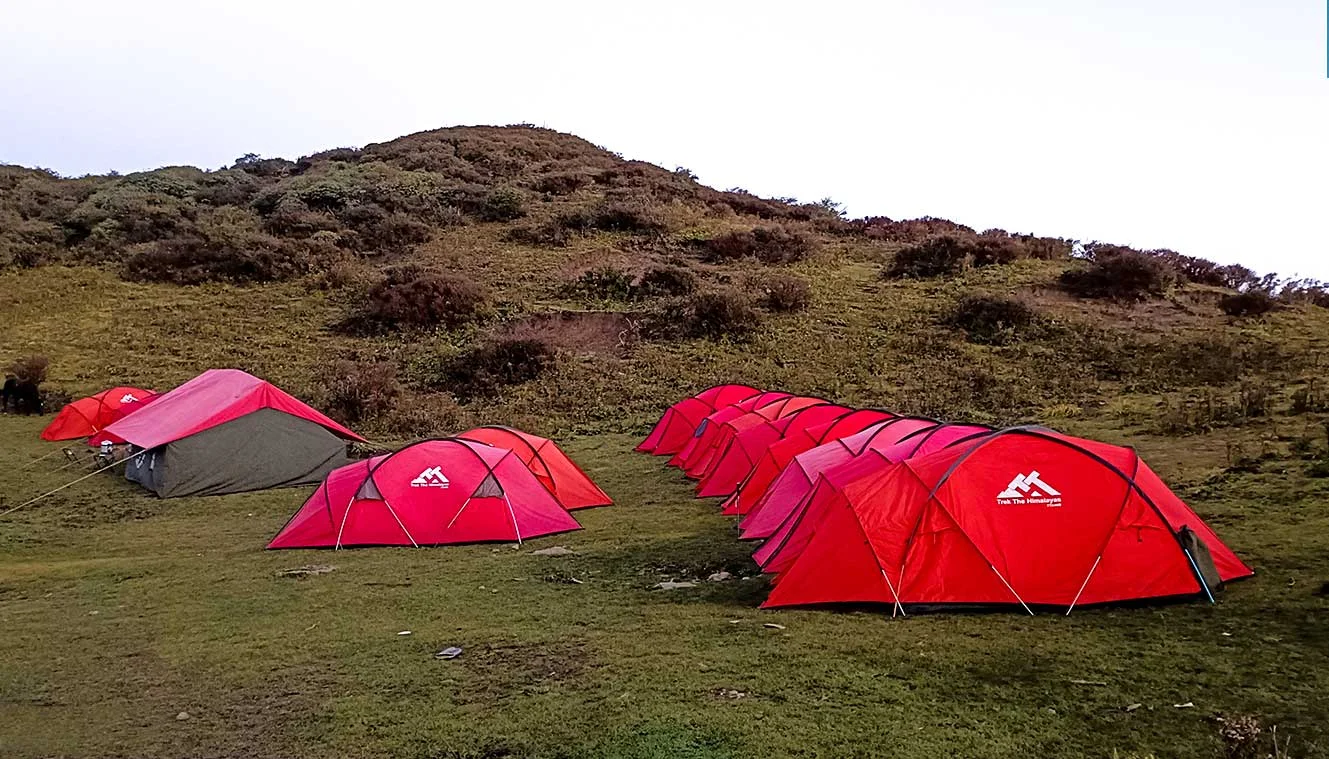
Trek From Thakom To Aal
From Thakum, you will have to take the route that branches into the southwest direction towards Aal. Aal is the closest campsite to Sandakphu summit and is set in a scenic location. Today’s trek is not as tiring as other days and the trail is extremely today. A few kilometers ahead of Thakom lies the Aal campsite, which offers a very beautiful view of the Kanchenjunga Ranges and the adjacent peaks. Enjoy a hot lunch at the Aal campsite today and you have the evening to spend at your leisure exploring the area.
From Thakom it's about an 8km walk to Aal. Follow the hiking trail and it will lead you to the Aal campsite. On a clear day, you can see stunning views of the Sleeping Buddha formation. You will be staying in tents in Aal and you can see beautiful Himalayan views from here. You are still in Nepal territory and as you move towards Sandakphu you will again move to Indian territory. Rest well in Aal and tomorrow we will trek to Sandakphu.
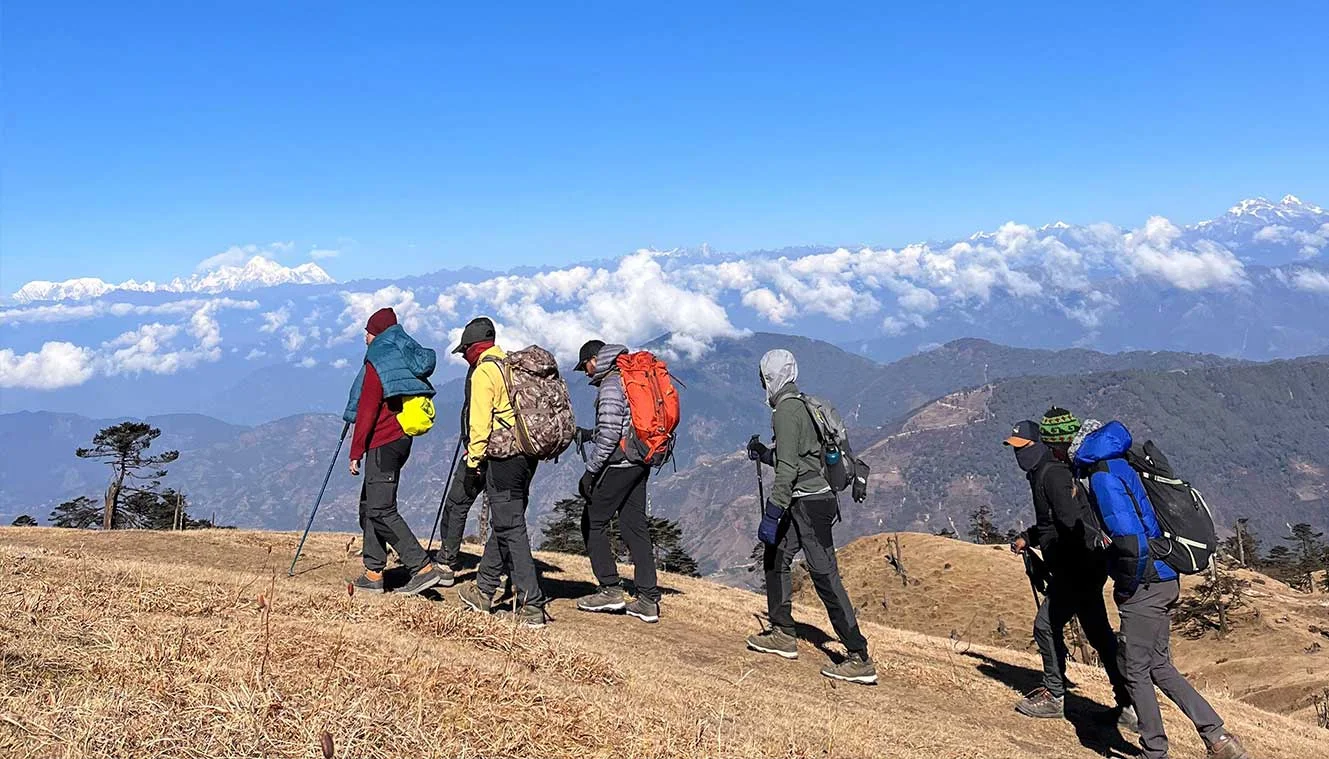
Trek From Aal To Timbure via Sandakphu
The stretch from Aal to Timbure is about 14 km. As we start from Aal after 3km we will reach Sandakphu. We start early in the morning so that you can watch the sunrise from the top of Sandakphu. It is one of the prettiest sights we will ever see. The first rays of sun over the snow-capped sleeping buddha cover it in an alpenglow that is way too beautiful to be described in words.
Watching the sunrise at Sandakphu and spending some time at the summit we will head towards Timburey, our next campsite. From Sandakphu it is about 10km to Timburey and takes about 4 hours to complete. As you head towards Timburey, Gurdum is the first village that you will come across. Gurdum is a postcard-perfect village with only 4 to 5 dwellings. It is one of the remote Himalayan villages. Surrounded by forests and Himalayan mountains, Gurdum also offers a private stay for tourists in its scenic setting.
Timburey is not far from here. After trekking for another 3 km you will arrive at Timburey, your campsite for the night. There are also a couple of home stays here and we will be staying at one of the local tea houses.
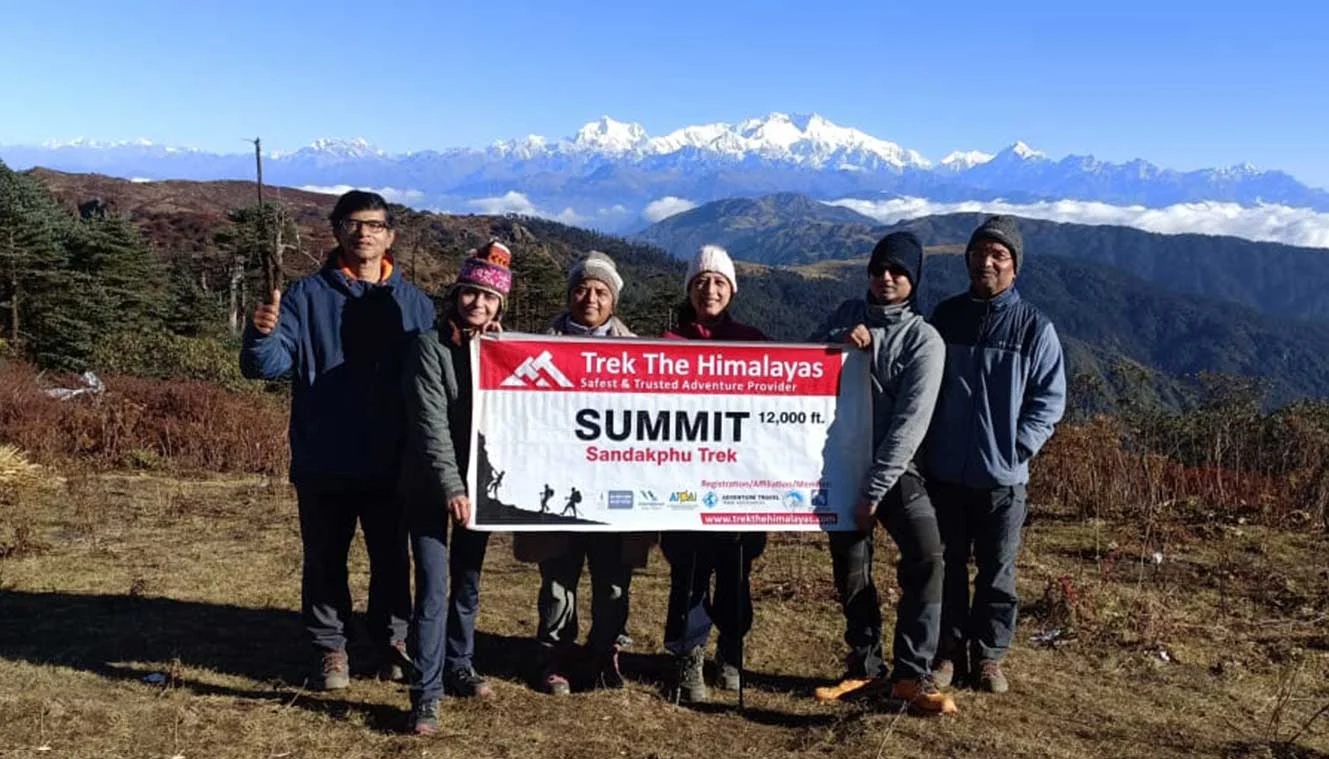
Trek From Timburey To Srikhola And Drive To NJP
This is the last day of your trekking and also the last day in the mountains. Your beautiful journey to Sandakphu ends today. From Timburey, we start our trek towards Srikhola again. It's a 3 km descent to Srikhola and takes about an hour. Once we reach Srikhola road-head, a vehicle will be waiting for you that will drive you back to NJP Railway Station. These are the same roads that you came in at the start of your journey. Reminisce about the mountains as you head back onwards on your journey, taking back with you wonderful memories of Sandakphu.
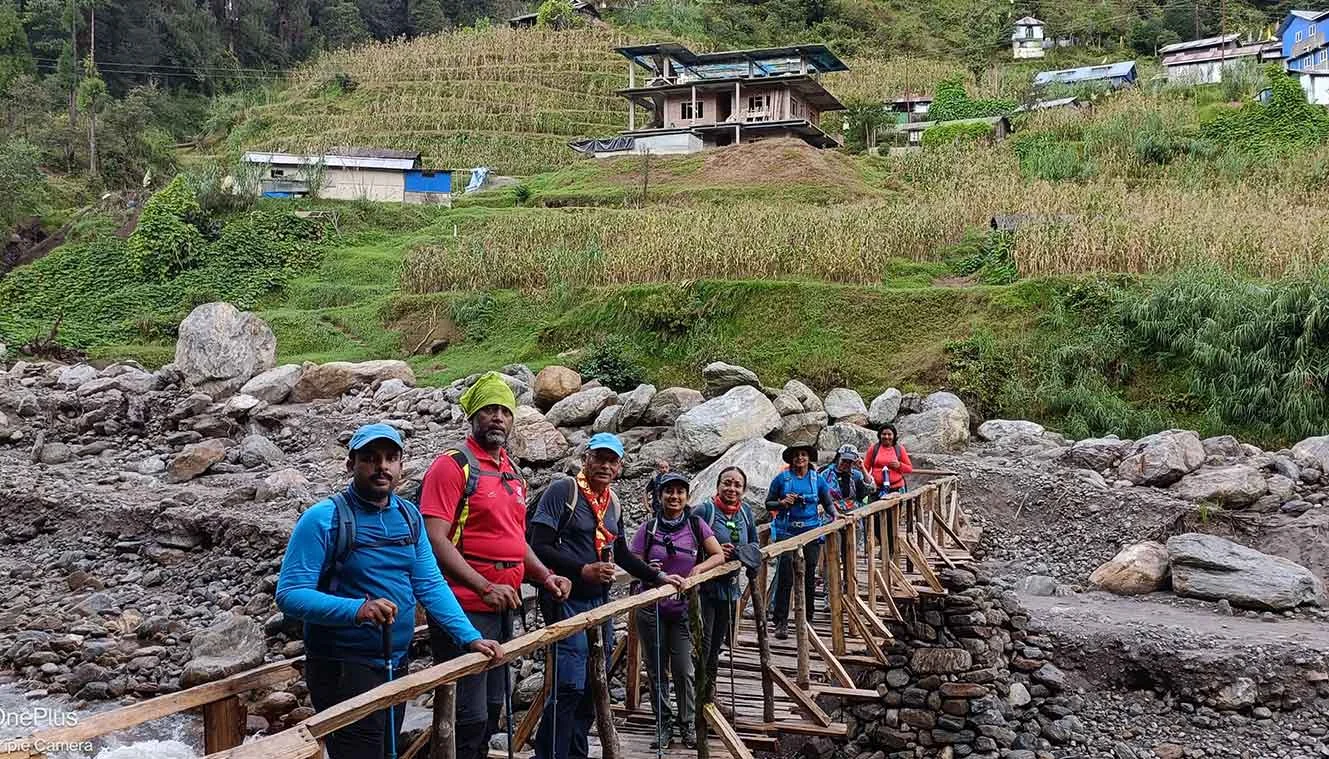
Day-1: Drive From NJP To Sepi
- Altitude: 6,400 ft.
- Drive Distance: 130 km.
- Stay: Teahouse.
- Pick-up time is 10.00 AM from NJP railway station.
- Transportation Amount is not included in the trek cost.
- Breakfast and Lunch exclude, and Dinner included.
Day-2: Trek From Sepi To Gorkhey via Ramam-Samanden
- Altitude: 7,545 ft.
- Trek Distance: 15 km.
- Altitude gain: 1295 ft.
- Lunch on the way.
- Stay in Teahouse.
Day-3: Trek From Gorkhey To Phalut
- Altitude – 11450 Ft.
- Trek Distance – 15 Km.
- Altitude Gain – 3905 Ft.
- Hot lunch on the way at aalu bari.
- Stay in camps.
Day-4: Trek From Phalut To Thakom
- Altitude – 11217 Ft.
- Trek Distance – 10 Km.
- Altitude Less – 233 Ft.
- Packed lunch on the way .
- Accommodation in camping.
Day-5: Trek From Thakom To Aal
- Altitude – 11600 Ft.
- Trek Distance – 11 Km.
- Altitude Gain – 383 Ft.
- Hot lunch at Aal campsite.
- Accommodation in camping.
Day-6: Trek From Aal To Timbure via Sandakphu
- Altitude – 6560 Ft.
- Sandakphu Altitude – 11930 ft.
- Trek Distance – 14 Km.
- Altitude Gain – 330 Ft.
- Altitude less – 3700 Ft.
- Hot lunch on the way at Gurdum.
- Accommodation in Tea House.
Day-7: Trek From Timburey To Srikhola And Drive To NJP
- Altitude Less-
- Trek Distance – 3 km (1 hrs).
- Drive Distance – 130 Km (6 hrs.)
- You will reach NJP by 06.00 pm.
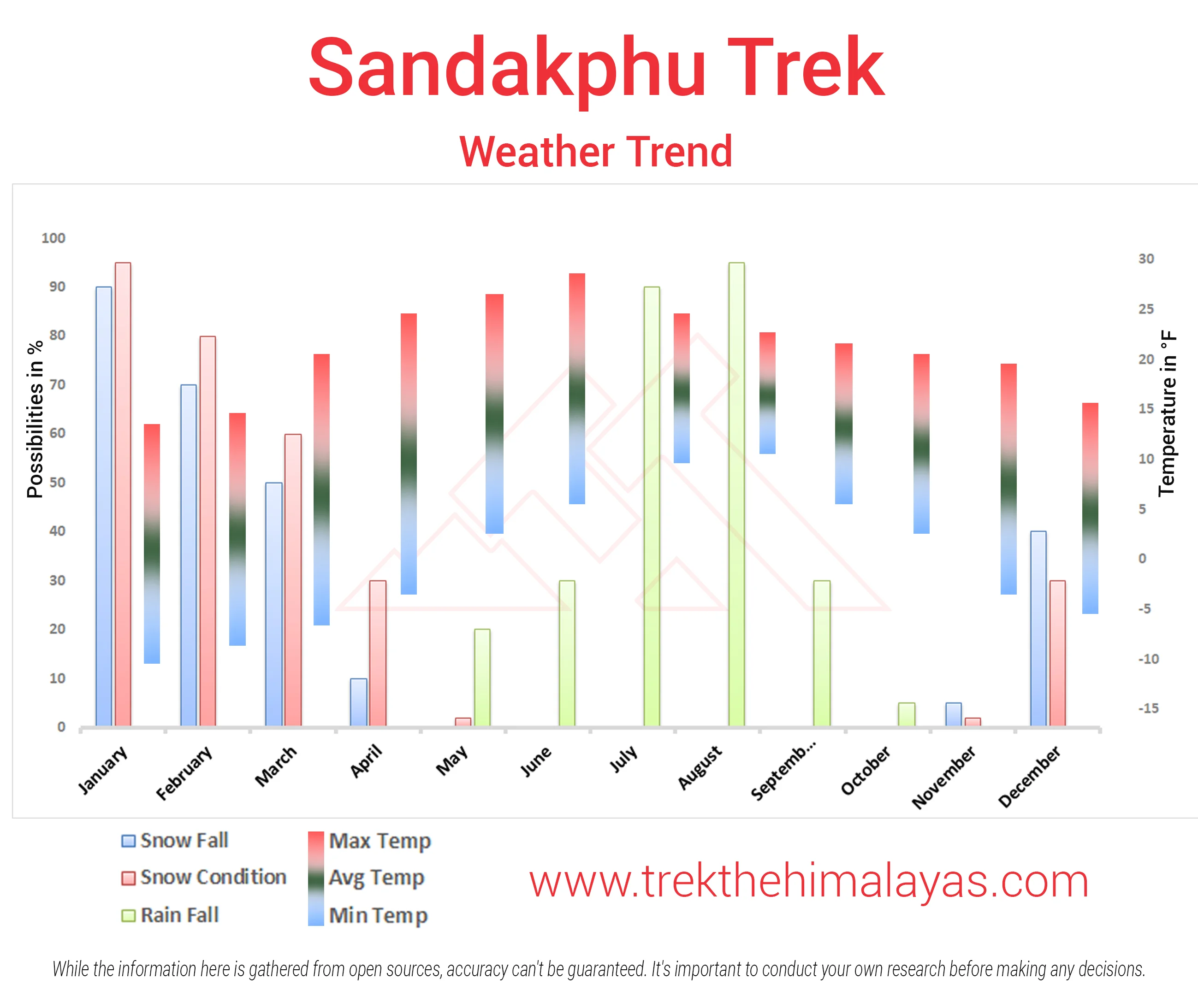
Important Links
- Mandatory Documents to Bring on A Trek Click Here.
How To Reach
It is essential for everyone to arrive at New Jalpaiguri Junction (NJP) (10:00 am)
Once you have reached New Jalpaiguri Junction (NJP), TTH will manage the rest of your travel arrangements, if you have opted for TTH's pick-up service, you can select this option during the booking process by adding it as an add-on.
Options to reach New Jalpaiguri Junction (NJP) railway station.
1. Take a flight to Bagdogra Airport in West Bengal, and take a cab to NJP railway station, it’s 20 km away and will take 45 minutes.
-
Domestic: There are various direct and indirect flights from other cities. You can take direct flights from Delhi, Kolkata, Guwahati and other cities.
-
International: International terminal is well equipped with modern amenities. Druk Air is the airline which provides international flights to the passengers. International flights connect with Paro in Bhutan and Bangkok. These flights are direct and comfortable.
2. Take a train to New Jalpaiguri Junction (NJP) that is well-connected to major cities like Kolkata, Guwahati, Delhi and Mumbai.
If you prefer to travel independently, you can either take a government bus or book a private cab. Your trek coordinator will provide guidance on how to arrange for the bus or cab booking.
Arrive in New Jalpaiguri (NJP) by 4:00 pm.
The designated drop-off point is NJP railway station.
Please consider planning your subsequent travel arrangements after 5:30 pm.
The distance from Railway Station to Bagdogra Airport is 20 km, it will take approx 40 minutes.
TTH offers comfortable transportation through Xylo, Bolero, or equivalent vehicles. If you wish to upgrade your mode of transportation, please contact your trek coordinator for further assistance.
.webp)
Cost Terms
Inclusion
1. Accommodation (as per the itinerary):
- Day 1, Day 2, and Day 6 Stay in a Tea house (Triple/quad sharing Male and female separately ).
- Day 3, Day 4, and Day 5 in a Tent (2 people in one tent).
2. Meals (Veg + Egg):
- Dinner at Sepi on Day 1 to Breakfast at Timbure on Day 7 as per the itinerary.
3. Support:
- 1 Versatile base camp manager: handles communication and deploys extra manpower in emergencies.
- 1 Mountaineering & First aid qualified professional trek Leader.
- 1 Experienced high altitude chef.
- Local experienced guides (Number of guides depending on the group size).
- Enough support staff.
4. Trek equipment:
- Sleeping bag, Sleeping liners (if required), Mattress, Utensils.
- 3 men all season trekker tent (twin sharing), Kitchen & Dining tent, Toilet tent.
- Camping stool, Walkie talkie.
- Ropes, Helmet, Ice axe, Harness, Gaiters & Crampon (if required).
5. First aid:
- Medical kit, Stretcher, Oxygen cylinder, Blood pressure monitor, Oximeter, Stethoscope.
6. Transportation (as per the itinerary):
- Transport from NJP to Sepi and return as per the itinerary.
7. Mules/porters to carry the central luggage.
8. Clock room facility available at the base camp for additional luggage
9. All necessary permits and entry fees, Upto the amount charged for Indian
10. Services from Sikkim to Sikkim.
Exclusion
1. Insurance (Mandatory).
2. Food during the transit..
3. Any kind of personal expenses.
4. Mule or porter to carry personal luggage.
5. Emergency evacuation, hospitalization charge or etc.
6. Anything not specifically mentioned under the head Inclusion.
7. Transport cost.
Things can be provided on demand and availability (participant has to pay extra for these things).
1- Satellite phone/set phone - is a type of mobile phone that connects via radio links via satellites orbiting the Earth instead of terrestrial cell sites like cellphones. Therefore, they can operate in most geographic locations on the Earth's surface.
2- Gamow/PAC HAPO Bag (Portable Hyperbaric Bag) - is a unique, portable hyperbaric chamber for the treatment of acute mountain sickness (AMS), also known as altitude sickness.
3- AEDs (Automated External Defibrillators) - are portable life-saving devices designed to treat people experiencing sudden cardiac arrest, a medical condition in which the heart stops beating suddenly and unexpectedly.
Cancellation terms:
Cancellations prior to 25 days from the start of the Trip
Refund options
- 5% deduction of trek fee
- 100% cash voucher for any trip till one year
- Transfer your trek (any trek, any date) to your friend
Cancellation between 24 days and 15 days to the start of the Trip
Refund options
- 30% deduction of trek fee
- 100% cash voucher for same trip till one year
- 85% cash voucher for any trip till one year
- Transfer your trek (same trek, any date) to your friend
Cancellation between 14 days and 10 days to the start of the Trip
Refund options
- 50% deduction of trek fee
- 80% cash voucher for same trip till one year
- 70% cash voucher for any trip till one year
- Book the same trek, in the same season, with any other batch
- Transfer your trek (same trek, any date) to your friend
Cancellation less than 9 days to the start of the trek
Refund options
- No cash refund
- 20% cash voucher for the same trip till one year
- 10% cash voucher for any trip till one year
- Transfer your trek (same trek, same date) to your friend
Note- If a booking is made using a voucher or discount code, the policies related to vouchers and discounts cannot be modified.
In the unlikely event that TTH cancels a trek prior to the scheduled departure date:
While it is extremely rare for TTH to cancel a trek, we understand that unforeseen circumstances or natural disasters may occasionally require us to do so before the scheduled departure. These circumstances could include continuous rain or snow, thunderstorms, snowstorms, landslides, floods, earthquakes, or any other natural calamity that poses a risk to the safety of our trekkers. Additionally, unforeseeable events such as local riots, curfews, pandemics, lockdowns, government orders, or any similar situations that compromise the safety of the trekking experience may also necessitate a cancellation.
In the event of such a cancellation, TTH will provide you with a voucher equivalent to the amount you paid for the trek. This voucher can be redeemed for any of our treks within the next year, allowing you to still enjoy an adventure with us at a later date.
Note
-
The issuance of a voucher is not applicable in situations where you are required to descend from the trek for any reason. The trek leader may make the decision to send you down from the trek due to factors such as insufficient fitness level, symptoms of Acute Mountain Sickness (AMS), high blood pressure, exceeding the designated turn-around-time, health concerns, or if you are found smoking, drinking, or violating the rules set for the trek. In such cases, the provision of a voucher does not apply.
In the rare event that TTH shifts a trek:
We would like to emphasize that weather conditions in high-altitude areas are highly unpredictable and can undergo sudden changes at any time, irrespective of the day. Additionally, circumstances beyond our control, such as natural disasters, political unrest, pandemics, and lockdowns, may impact the feasibility of conducting a trek. In cases where we are unable to proceed with an event due to such circumstances that are beyond our direct control, we will make every effort to provide you with an alternative trek that is safer and more suitable.
In such situations, we will issue a voucher to offset the cost difference between the originally scheduled trek and the alternative trek. This voucher can be redeemed at any time within one year from the date of issue. Please note that a refund fee or reimbursement of the cost difference is not applicable in these cases.
Note:
- Change of trek batch is dependent on the availability of seats in the batch
- In case of transferring a trek to a friend, he/she should satisfy all the mandatory requirements put forward by TTH
- TTH holds the right to change/cancel the policies, without prior notice
- Cash refund is applicable only in case of bookings made without using any promotional offer code or vouchers
Cash Voucher Terms:
- This is a non-transferable voucher
- The voucher cannot be merged with any other offer of Trek The Himalayas
- The voucher is valid for Trek booked directly with Trek The Himalayas in India
- To avail the voucher please use your register phone number or e-mail id
- All the other Terms of booking a trek with Trek The Himalayas are applicable to the voucher
- Trek The Himalayas holds rights to add/remove any of the Terms and Conditions without prior notice
Itineraries are based on information available at the time of planning and are subject to change. "Trek The Himalayas" reserves the right to change expedition dates, people or itineraries as conditions warrant. If a trip must be delayed or the itinerary changed due to bad weather, road conditions, transportation delays, government intervention, airline schedules, sickness, or other contingency for which TTH or its agents cannot make provision, the cost of delays and/or other changes are the responsibility of the participant. TTH reserves the right to decline, or accept, any individual as a trip member for any reason whatsoever.
Trek Essentials
PDF Of Trek Essential Download
| Backpack with rain cover | (50 - 60 ltr) with comfortable shoulder straps |
| Day pack with rain cover | 20 - 30 ltr (If off-load opted) |
| Walking stick | Advisable (At least one) |
| Water Bottle / Hydration pack | 2 thermos flask bottles of one liter each, Avoid hydration pack. |
| Small size tiffin/lunch box | 1 Nos |
| Snacks | Energy bars, dry fruits, electoral/ors |
| Personal Medical Kit | Consult your doctor |
| T-Shirt (Synthetic quick dry) | 1 Full & 1 Half sleeves |
| Fleece T-shirt | 2 Nos |
| Wind stopper / Fleece jacket | 1 Nos |
| Windproof Jacket | 1 Nos |
| Down feather / Hollow jacket | 1 Nos. |
| Thermal inner (Upper and Lower) | 1 Pair |
| Trek Pant (Synthetic quick dry) | 1 Nos. |
| Wind stopper / Fleece Pant | 1 Nos |
| Waterproof gloves | 1 Pair |
| Fleece / woollen gloves | 1 Pair |
| Poncho / waterproof Jacket and pant | 1 Nos. |
| Sunscreen | 1 Nos. |
| Moisturiser | 1 Nos. |
| Chap-stick / Lip balm | 1 Nos. |
| Toothbrush and toothpaste | 1 Nos. |
| Toilet paper & Wipes | 1 Nos. |
| Hand sanitizers | 1 Nos. |
| Antibacterial powder | 1 Nos. |
| Quick dry towel | 1 Nos. |
| Head torch | 1 Nos. (Avoid Hand torch) |
| Sun Cap | Not required |
| Woolen cap | 1 Nos. |
| Balaclava | 1 Nos. |
| Buff / Neck-gaiters | 2 Woollen |
| Sunglasses | UV with dark side cover, People who wear spectacles - (A)- Use contact lenses | (B)- Photo chromatic glasses |
| Trekking shoes | 1 Pair (Waterproof, high ankle, good grip) |
| Floaters / flip-flops | Not required |
| Cotton socks | 4 pairs |
| Woollen socks | 3 pairs |
| Gaiters | 1 Pair (TTH provides when required) |
| Micro spikes | 1 Pair (TTH provides when required) |

Frequently Asked Questions(FAQ)
To register with TTH, visit our website - www.trekthehimalayas.com and create your account. To create your account you will need to use your email address and fill in all the details, set your unique password and your account is ready to use.
- To book a trek with TTH, you first need to register with us and create an account.
- Choose the trek that you want to do and click on available dates.
- You will land at the login page, fill in the required details.
- Add Participants, choose add-on services click on the Pay now button, choose your preferred payment method, and make the payment. TTH accepts multiple payment options, including credit/debit cards, net banking, and UPI.
- You will receive a confirmation email from TTH with all the necessary details about the trek, including the meeting point, transportation, accommodation, and other important instructions.
please send an email to us at info@trekthehimalayas.com or reach out to the numbers provided in the Help and Support section of your Trek Page. We will ensure that your issue is promptly resolved.
To book services such as off-load luggage and transportation, you can find them listed as add-ons. These additional services can be booked at the time of your initial booking. If you miss booking add-ons during the initial reservation, you can log in anytime and easily book 4 days before the departure date add-ons through the platform.
In such a situation, please log in to your account and transfer your trek or date to the desired one within 12 hours or drop us an email at info@trekthehimalayas.com 10 days before the departure date of the trek. After the initial 12-hour period, any changes will be processed according to the cancellation policy.
We recommend visiting our "Suggest Me a Trek" page. By filling out the form, our experts will contact you with the best possible trek options based on your preferences and experience level. Alternatively, you can reach out to us via email at info@trekthehimalayas.com or give us a call using the numbers provided on our website for personalized assistance and recommendations.
Family treks differ from regular treks by focusing on ease of difficulty, offering shorter durations for younger participants, Kid-friendly and easily digestible foods, child-friendly activities, maintaining a higher guide ratio for diverse age groups, and implementing additional safety measures for families.
Family Trek with Kids recommendation Only Dayara Bugyal and Chopta Chandrashila Trek.
Minimum age for TTH treks is typically 7 years, though this may vary depending on the specific trek.
Yes, you can take a kids to a high-altitude trek with a parent. Discuss with a trek expert before booking a trek.
Junior trekkers (below 15 years) should have a company of parents/guardians.
Trekkers between 15 to 18 years can come solo with the disclaimer form signed by parent/guardian.
Medical & Disclaimer Form (Mandatory Documents) Click here to download medical and disclaimer form
Physical Fitness: Ensure your child is physically fit. Engage them in regular exercise, outdoor activities, and hikes to build stamina and endurance. Hydration: Emphasize the importance of staying hydrated at high altitudes. Encourage your child to drink water regularly, even if they don't feel thirsty. Proper Nutrition: Provide a well-balanced diet with sufficient carbohydrates for energy and foods rich in iron to prevent altitude sickness. Adequate Sleep: Ensure your child gets enough sleep in the days leading up to the trek. Quality rest is crucial for altitude adaptation. Educate on Altitude Sickness: Teach your child about the symptoms of altitude sickness, such as headache, nausea, and dizziness. Encourage them to communicate any discomfort immediately. Appropriate Clothing and Gear: Dress your child in layers to adjust to changing temperatures. Ensure they have appropriate trekking gear, including sturdy footwear. Positive Mindset: Foster a positive mindset. Encourage your child, and let them know it's okay to take breaks when needed. Medical Check-Up: Schedule a medical check-up before the trek to ensure your child is fit for high-altitude activities. Consult with a healthcare professional about any potential health concerns.
TTH takes special care to provide wholesome and nutritious food for children on treks. Here are some of the foods that are typically served for children:
Breakfast: For breakfast, TTH serves a variety of options like porridge, cornflakes, bread, butter, jam, honey, boiled eggs, omelettes, and pancakes. Children can choose from these options to fuel themselves for the day's trek.
Lunch: For lunch, TTH serves lunch which includes rotis, vegetables, rice, dal, and salad. The rotis are usually made fresh on the trek and are a good source of carbohydrates. The dal and vegetables provide protein and other essential nutrients.
Snacks: TTH provides healthy snacks like fresh fruits, dry fruits, energy bars, cookies, and biscuits to keep the children energized throughout the day.
Dinner: For dinner, TTH serves a hot and wholesome meal which includes soup, rice, dal, vegetables, and a non-vegetarian dish (if requested in advance). Children can also choose from a variety of desserts like custard, jelly, and fruit salad.
Dietary requirements: If a child has any special dietary requirements, TTH can cater to those needs as well. For example, if a child is lactose intolerant or allergic to nuts, the kitchen staff can make arrangements to accommodate those requirements.
Choosing the right trek for a beginner can be a bit overwhelming as there are many factors to consider such as distance, elevation gain, terrain difficulty, weather, and time of year. Here are some tips that can help you choose the right trek for a beginner:
1. Determine fitness level: Assess the fitness level of the beginner to understand their physical capabilities. This will help you select a trek that is challenging but not too difficult.
2. Choose a well-traveled trail: A well-traveled trail will have more amenities such as signposts, water stations, and shelter. It is also safer as there will be other hikers on the trail.
3. Consider the length of the trek: For beginners, it is recommended to start with a shorter trek that can be completed in a day or two. This will help them get acclimatized to trekking and build their confidence.
4. Look for gradual elevation gain: Choose a trek with a gradual elevation gain rather than steep ascents. This will make the trek easier and more enjoyable.
5. Check the weather: Check the weather forecast before selecting a trek. Avoid treks during the monsoon season or winter when the trails can be slippery or dangerous.
6. Research the trail: Read about the trail to get an idea of the terrain, altitude, and difficulty level. This will help you select a trek that is suitable for the beginner.
7. Consult with an expert: If you are unsure about which trek to choose, consult our trek expert Mr. Nitin (+91 70600 59773) between 10 AM to 6 PM (Tuesday - Friday). Mr. Nitin will provide you valuable advice and guidance.
Overall, it is important to choose a trek that is enjoyable, challenging but not too difficult, and suitable for the beginner's fitness level and experience.
It is not recommended for a beginner to choose a difficult Himalayan trek. Trekking in the Himalayas can be physically and mentally challenging, especially if you are not used to the high altitude, steep slopes, and rugged terrain. Choosing a difficult trek without the proper experience, fitness level, and preparation can be dangerous and put you at risk of altitude sickness, injury, and other hazards.
If you are a beginner, it is recommended to start with an easier trek and gradually build up your skills and experience. This will help you understand the challenges of trekking in the Himalayas, and also prepare you physically and mentally for a more difficult trek in the future. It is also important to choose a trek that matches your fitness level, experience, and interest.
There is no specific age limit for a beginner trekker. However, it is important to consider your physical fitness, health condition, and personal interests before embarking on a trek. Trekking in the Himalayas can be physically and mentally demanding, and requires a certain level of physical fitness and endurance.
If you have any pre-existing medical conditions or are above a certain age, it is recommended to consult with a doctor before embarking on a trek. It is also important to listen to your body and take breaks as needed during the trek to prevent exhaustion or injury.
We recommend visiting our "Suggest Me a Trek" page. By filling out the form, our experts will contact you with the best possible trek options based on your preferences and experience level. Alternatively, you can reach out to us via email at info@trekthehimalayas.com or give us a call using the numbers provided on our website for personalized assistance and recommendations.
Yes, you can join the trek. We have fixed departure groups where you can simply book your trek and we will take care of curating a group.
Before you start the trek, it is recommended that you make all the necessary phone calls as during the trek you may or may not receive network coverage, once you come back to the Base Camp, you can reconnect with your family via phone once again. You can share your trek coordinator contact detail with your family members to get the latest updates about your trek batch.
At TTH, we provide wholesome and nutritious meals during the trek. The food is vegetarian and includes a variety of dishes such as rice, dal, vegetables, chapati, paratha, pasta, noodles, and soup. We also offer snacks such as biscuits, and salty, and dry fruits during the trek. Special dietary requirements such as vegan, gluten-free, or Jain food can also be arranged if informed in advance.
If you are allergic to some foods, you need to let us know in advance so that we can make arrangements accordingly.
TTH is a trekking company that prioritizes the safety of all its participants, including women trekkers. They have a comprehensive safety system in place, which includes a dedicated team of experienced and trained trek leaders and support staff who are equipped to handle emergency situations and provide first aid.
TTH also takes specific measures to ensure the safety and comfort of women trekkers. They have a separate tent accommodation for women trekkers, female trek leaders, and support staff. They also provide separate toilet facilities for women and encourage a safe and respectful environment for all trekkers.
Moreover, TTH has a strict policy against any kind of harassment and has a zero-tolerance policy towards such incidents. They have a designated Internal Complaints Committee (ICC) to investigate and address any complaints related to harassment or misconduct. Overall, TTH has a good reputation for safety and responsible trekking practices, and women can feel comfortable and safe while trekking with them.
In case you are the only women in the group, we provide a single sleeping arrangement. Also, during the trek, the trek leader will always remain by your side to provide optimum safety and reassurance.
You can reach out to the trek coordinator to inquire about the number of female trekkers and their respective states who have booked the trek. Please note that the trek coordinator cannot disclose personal details of any trekker. Once you've confirmed your booking, a WhatsApp Group will be created for all the trekkers in your batch. This allows you to connect with fellow trekkers before the trek begins.
While many of our treks are led by female trek leaders, however, it is not possible to know which trek leader is assigned to which group. But nonetheless, whether the trek leader is male or female you can be completely assured of your safety and security with us.
Yes, it is possible to trek with periods. However, it is important to take some extra precautions and preparations to ensure a comfortable and safe trekking experience.
Here are some tips that can help you trek during your period:
1. Use menstrual hygiene products that you are comfortable with, such as tampons, pads, or menstrual cups. It is recommended to carry enough supplies for the entire duration of the trek.
2. Pack wet wipes, hand sanitizer, and plastic bags to dispose of used hygiene products.
3. Wear comfortable and breathable clothing that allows for easy movement and reduces friction. Avoid wearing tight or restrictive clothing that can cause discomfort.
4. Carry pain relief medication, such as ibuprofen or acetaminophen, in case of menstrual cramps.
5. Stay hydrated and maintain a balanced diet to support your energy levels and overall health.
6. Take breaks as needed and listen to your body. If you feel uncomfortable or experience any unusual symptoms, seek medical attention immediately.
It is also recommended to consult with a doctor before going on a trek during your period, especially if you have a pre-existing medical condition or are taking medication. By taking necessary precautions and being prepared, you can have a safe and comfortable trekking experience even during your period.
We provide proper disposal facilities for sanitary pad disposal during the trek.
We offer three person tents with twin-sharing for optimum comfort. A woman trekker will share a tent with another woman trekker and if you are the only woman in the group, you will be given a single accommodation for your comfort and privacy.
Yes, we do provide gears on rent. You can book it using you TTH account directly.
Mountaineering qualified Experienced and first aid certified Trek Leader, First Aid Certify local guide, Cook, helpers and supporting staff.
People suffering from Bronchitis, Asthma, High blood pressure, Epilepsy (got faints), TB , Heart problem or on higher BMI side are strictly not allowed to go on any Himalayan trek. Apart from this if you had any medical history, please let us know.
No. Alcohol and smocking isn’t allowed while on trek. It is totally misconception that it will keep you warm. Your body need to acclimatize properly and for that eat properly and drink enough water; these things will keep you warm.
Toilet tents provide a convenient solution for answering nature's call in the great outdoors. Dry toilets, in particular, offer a highly sanitary approach. By digging a pit and utilizing mud and a shovel, you can easily cover up your waste. This method ensures cleanliness and hygiene while camping or exploring in the forest.
Remember to pack essential toiletries to complete your outdoor bathroom kit and maintain proper personal hygiene during your adventures. With these practices in place, you can enjoy nature while also respecting it.
Layer Up From Head To Toe
Eat Full Meals, never sleep empty stomach
You can keep warmee (if you’re more susceptible to cold).
Use sleeping bag in right way and don’t leave free space in sleeping bag.
For upper body
– Thermal layer
– T-shirt (full-sleeves)
– Fleece T-shirt (for extreme colds)
– Fleece layer
– Thick Jacket/Down Jacket
– Waterproof or Windproof layer (outermost layer, when it is snowing or raining)
- For Lower Body
– Thermal layer
– Hiking pants (normal) or Winter hiking pants
Based on how warm you feel you can skip any of the above layers. Your outer later should be windproof since it is windy at high altitude.
The idea behind layering is that the more insulation you have the less cold you feel, and instead of wearing a very thick jacket if you wear multiple layers, your body will be better insulated against the cold.
Yes, we provide micro spikes and gaiters, if required.
Mandatory documents: 2 xerox of ID having address (addhar card/driving license), 2 Passport size photographs, hard copy Medical form signed & sealed by doctor, disclaimer form sign by trekker and high altitude insurance.
No. We don’t but we can suggest you good hotel/Stay nearby pick up location.
Yes, trekker must carry 2 water bottles 1 litre each so they can refill it at campsite for drinking and keep themselves hydrate.
You should buy shoes which has these three features –Good grip, Ankle Support and additional water resistant layers. Generally, we advise Quechua Trek 100, MH 500 and MH 100.
Your return transport is also included in trek fee if you're opting for service Dehradun to Dehradun ; we use Tempo Traveller/ Tata Sumo/Max/Boloero kind of vehicle.
No one is forced to go on. There is always enough staff to split the party according to need and regroup later at the camp. Most people have no trouble reaching the highest campsite. If some members decide not to climb the final distance they can wait for the climbers to come back down the same way or take a lateral path to the descent route.
We always have a first aid kit close at hand. Serious injuries are rare. Porters will assist injured climbers to the base of the mountain and onward to a clinic or hospital. Kilimanjaro International Airport is very near Marangu Gate if evacuation to the US or Europe is advisable.
Sandakphu Trek is a 68 km trek.
Sandakphu is located in the Indian state of West Bengal, Sikkim region.
Sandakphu Trek is a moderate to difficult grade trek.
Sandakphu Trek can be done in all seasons, summer (Mid Apr-Jun), autumn (Sep - Mid-Nov), Winter (Mid-Nov - Mid Feb), and Spring (Mid Feb - Mid-Apr).
Yes, it is highly recommended to hire a professional expert for the Sandakphu Trek, especially if you are a beginner or have limited trekking experience. A professional can provide you with valuable assistance, including knowledge of the local terrain, weather conditions, and the culture of the region. They can also help you with navigation and ensure your safety throughout the trek.
During the Sandakphu Trek, you will stay in 3 nights in the teahouses and 3 nights in the Tent.
Here are some of the essentials you should pack for the trek:
1. Trekking shoes: A good pair of trekking shoes is essential for a comfortable trek. Make sure your shoes are well-fitted, sturdy and provide good grip on the trail.
2. Warm Clothing: The weather can be unpredictable in the mountains, so it's important to carry warm clothing, including thermal innerwear, fleece jackets, down jacket, and waterproof jacket.
3. Trekking pants: Carry comfortable and quick-drying trekking pants that are suitable for the weather conditions.
4. Backpack: A good quality backpack with a capacity of 40-50 liters is ideal for carrying your essentials during the trek.
5. Sleeping bag: A good quality sleeping bag is essential for a comfortable stay during the camping nights.
6. Headlamp/Flashlight: Carry a good quality headlamp or flashlight with extra batteries for trekking during early morning or late evening hours.
7. Water bottle: Carry a reusable water bottle and stay hydrated throughout the trek.
8. Snacks: Carry energy bars, dry fruits, and snacks for instant energy during the trek.
9. First aid kit: Carry a basic first aid kit, including band-aids, antiseptic cream, pain relief spray, and medicines for altitude sickness.
10. Sun protection: Carry sunscreen lotion, sunglasses, and a hat to protect yourself from the harsh sun rays.
11. Trekking poles: Trekking poles can help in maintaining balance and reduce the strain on your knees while trekking.
Yes, permits are required for the Sandakphu Trek. The trek passes through the Singalila National Park, which is a protected area and requires permits for entry. The permits required for Sandakphu Trek are Singalila National Park Permit, West Bengal Forest Department Permit, and Sikkim Tourism Department Permit. When you trek with us, Trek The Himalayas obtains all the permits for you.
In the Himalayas is a challenging and unpredictable activity, and undertaking it alone can be risky and dangerous. The Sandakphu Trek is a high-altitude trek that requires good physical fitness, proper acclimatization, and knowledge of the terrain. It is also essential to have adequate equipment, including warm clothing, proper footwear, a reliable tent, and a sleeping bag. Going solo means taking on all these responsibilities and risks alone, which can be overwhelming for inexperienced trekkers.
In addition, the Sandakphu Trek passes through remote areas, and there is limited access to medical facilities and emergency services. Going with a group or a guide provides an added layer of safety and security, as they are trained to handle any situation that may arise during the trek. Therefore, it is highly recommended to go with a reputable trekking company or an experienced guide for the Sandakphu Trek. This will ensure a safe and enjoyable trekking experience, with the added benefit of local knowledge, group support, and a hassle-free journey.
.webp)
